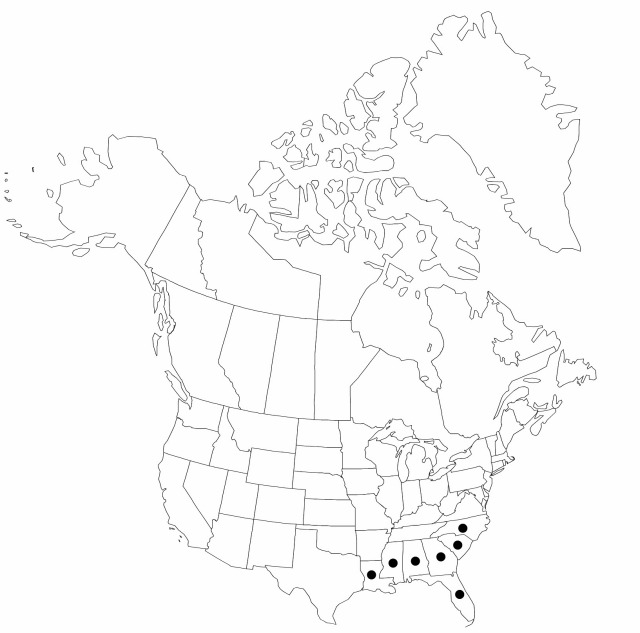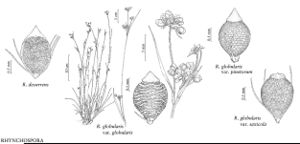Difference between revisions of "Rhynchospora decurrens"
Fl. South. U.S., 525. 1860.
FNA>Volume Importer |
imported>Volume Importer |
||
| (5 intermediate revisions by 2 users not shown) | |||
| Line 6: | Line 6: | ||
|place=525. 1860 | |place=525. 1860 | ||
|year=1860 | |year=1860 | ||
| + | }} | ||
| + | |special_status={{Treatment/ID/Special_status | ||
| + | |code=F | ||
| + | |label=Illustrated | ||
| + | }}{{Treatment/ID/Special_status | ||
| + | |code=E | ||
| + | |label=Endemic | ||
}} | }} | ||
|basionyms= | |basionyms= | ||
| Line 11: | Line 18: | ||
|name=Phaeocephalum decurrens | |name=Phaeocephalum decurrens | ||
|authority=(Chapman) House | |authority=(Chapman) House | ||
| + | |rank=species | ||
}} | }} | ||
|hierarchy=Cyperaceae;Rhynchospora;Rhynchospora decurrens | |hierarchy=Cyperaceae;Rhynchospora;Rhynchospora decurrens | ||
| Line 35: | Line 43: | ||
-->{{#Taxon: | -->{{#Taxon: | ||
name=Rhynchospora decurrens | name=Rhynchospora decurrens | ||
| − | |||
|authority=Chapman | |authority=Chapman | ||
|rank=species | |rank=species | ||
| Line 49: | Line 56: | ||
|publication title=Fl. South. U.S., | |publication title=Fl. South. U.S., | ||
|publication year=1860 | |publication year=1860 | ||
| − | |special status= | + | |special status=Illustrated;Endemic |
| − | |source xml=https:// | + | |source xml=https://bitbucket.org/aafc-mbb/fna-data-curation/src/2e0870ddd59836b60bcf96646a41e87ea5a5943a/coarse_grained_fna_xml/V23/V23_398.xml |
|genus=Rhynchospora | |genus=Rhynchospora | ||
|species=Rhynchospora decurrens | |species=Rhynchospora decurrens | ||
Latest revision as of 20:40, 5 November 2020
Plants perennial, cespitose, to 100 cm; rhizomes sometimes produced, short, not stoloniferous. Culms lax, erect to ascending-excurved, ± terete, leafy, slender, soft. Leaves exceeded by inflorescence; blades erect or ascending, linear, proximally flat, 2–4 mm wide, apex trigonous, subulate, tapering. Inflorescences: spikelet clusters 4–6, widely spaced, loose, broadly to narrowly turbinate, paniculate, branches capillary, ultimate branches with 1 or 2 spikelets; leafy bracts exceeding proximal clusters, setaceous. Spikelets solitary or in 2s, brown, ovoid, 2.5–3.5 mm; fertile scales ovate, 1.5–2.2 mm, apex acute, apiculate. Flowers: perianth bristles 6, reaching tubercle base or slightly beyond, antrorsely barbellate. Fruits 2–3 per spikelet, 1.5–1.6(–1.8) mm; body brown or greenish, obovoid, lenticular, 1.1–1.2(–1.3) × 0.7–1 mm, margins narrow, distinct, sharp, flowing to tubercle; surfaces finely transversely wavyrugulose, intervals of fine, nearly isodiametric or vertical-rectangular pitlike alveolae; tubercle lowtriangular, entire, 0.3–0.4 mm.
Phenology: Fruiting late spring–summer.
Habitat: Sandy alluvium of swamp forests and environs
Elevation: 0–100 m
Distribution

Ala., Fla., Ga., La., Miss., N.C., S.C.
Discussion
Rhynchospora decurrens superficially resembles R. mixta, with which it is often associated in swamp forests. Its narrower fruit bodies with less distinct transverse rugosity; the smaller, more numerous rows of finer, pitlike alveolae; and its broader, lower tubercles with non-setose edges all comprise consistent differences. The name decurrens is apt, calling attention to the narrow, wirelike pale margins that extend from tubercle base to near the base of the fruit body.
Selected References
None.
